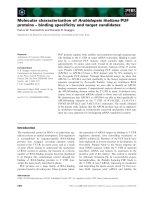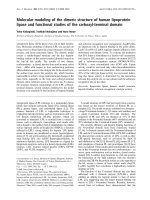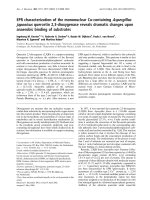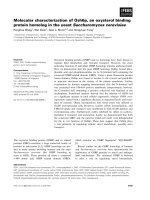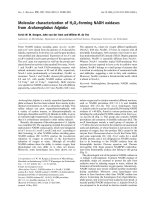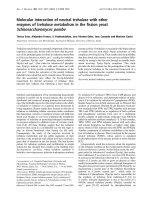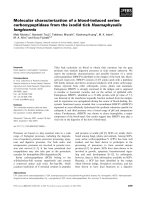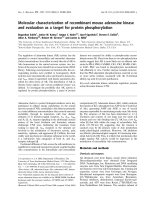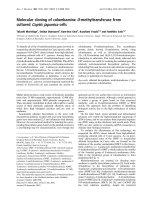Báo cáo Y học: Molecular characterization of MRG19 of Saccharomyces cerevisiae Implication in the regulation of galactose and nonfermentable carbon source utilization pdf
Bạn đang xem bản rút gọn của tài liệu. Xem và tải ngay bản đầy đủ của tài liệu tại đây (356.99 KB, 11 trang )
Molecular characterization of
MRG19
of
Saccharomyces cerevisiae
Implication in the regulation of galactose and nonfermentable carbon source
utilization
Firdous A. Khanday*, Maitreyi Saha and Paike Jayadeva Bhat
Laboratory of Molecular Genetics, Biotechnology Center, Indian Institute of Technology, Powai, Mumbai, India
We have reported previously that multiple copies of MRG19
suppress GAL genes in a wild-type but not in a gal80 strain of
Saccharomyces cerevisiae. In this report we show that dis-
ruption of MRG19 leads to a decrease in GAL induction
when S. cerevisiae is induced with 0.02% but not with 2.0%
galactose. Disruption of MRG19 in a gal3 background (this
strain shows long-term adaptation phenotype) further delays
the GAL induction, supporting the notion that its function is
important only under low inducing signals. As a corollary,
disruption of MRG19 in a gal80 strain did not decrease the
constitutive expression of GAL genes. These results suggest
that MRG19 has aroleinGAL regulation only when the
induction signal is weak. Unlike the effect on GAL gene
expression, disruption of MRG19 leads to de-repression of
CYC1-driven b-galactosidase activity. MRG19 disruptant
also showed a twofold increase in the rate of oxygen uptake
as compared with the wild-type strain. ADH2, CTA1,
DLD1,andCYC7 promoters that are active during non-
fermentative growth did not show any de-repression of
b-galactosidase activity in the MRG19 disruptant. Western
blot analysis indicated that MRG19 is a glucose repressible
gene and is expressed in galactose and glycerol plus lactate.
Experiments using green fluorescent protein fusion con-
structs indicate that Mrg19p is localized in the nucleus
consistent with the presence of a consensus nuclear locali-
zation signal sequence. Based on the above results, we pro-
pose that Mrg19p is a regulator of galactose and
nonfermentable carbon utilization.
Keywords: carbon metabolism; CYC1 repressor; GAL genes;
glucose repression; induction signal; transcriptional
regulator.
The reprogramming of molecular machinery mainly
brought about by transcriptional regulation, co-ordinates
different cellular processes as cells move from one physio-
logical state to another. Since this is the key for the
evolutionary success of any organism, it is not surprising
that significant fraction of their genetic endowment is
dedicated to regulatory functions. When yeast shifts from
the most preferred carbon source glucose to galactose, a
large increase in the synthesis of GAL gene products occurs,
without affecting its fermentative life style [1–4]. Obviously,
during this transition, yeast has to make compensatory
changes in the pattern of gene expression to co-ordinate
galactose metabolism with various other cellular processes,
especially energy metabolism. One of the obvious changes is
the de-repression of many glucose-repressed functions,
especially mitochondrial biogenesis [5–8]. Recently,
genome-wide analysis has identified genes which previously
were not suspected to be induced in presence of galactose,
emphasizing the importance of the need for multiple
pathways to integrate various cellular functions [9]. Study
of utilization of galactose by Saccharomyces cerevisiae
provides a convenient experimental system to probe into the
network of gene interaction leading to exquisite co-ordina-
tion between different cellular processes [10].
Gal4p, a DNA binding transcriptional activator, acti-
vates the GAL genes in response to galactose. Although
Gal4p remains bound to the upstream activating sequences
of GAL genes in noninducing conditions, Gal80p inhibits
transcriptional activation. This is due to a physical interac-
tion between Gal4p and Gal80p [11]. In response to
galactose, Gal3p interacts with Gal80p, thereby allowing
Gal4p to cause rapid transcription of GAL genes
[1,2,4,12,13]. The long-term adaptation phenotype exhibited
by a gal3 strain [14], is due to Gal1p, which has Gal3p-like
signal transduction activity in addition to galactokinase
activity [15]. Recent experiments have demonstrated that
Gal3p directly interacts with Gal80p in the presence of
galactose and ATP [16–19]. It has also been demonstrated
that a tripartite complex is formed between Gal3p-Gal80p-
Gal4p in response to galactose and ATP [3]. The current
view is that the interaction of Gal3p with Gal80p allows the
transcription-activating domain of Gal4p to interact with
the general transcription factors, thereby causing transcrip-
tion activation of GAL genes [20,21]. It has been suggested
that the interaction of Gal3p with Gal80p may not result in
the dissociation of Gal80p from Gal4p [22] but may cause
Gal80p to shift to a second site on Gal4p [19]. Based on the
results that Gal3p is cytoplasmic and Gal80p is distributed
in both the nucleus and the cytoplasm, it has been suggested
Correspondence to P. J. Bhat, Laboratory of Molecular Genetics,
Biotechnology Center, Indian Institute of Technology, Powai,
Mumbai 400 076, India.
Fax: + 91 22 572 3480, Tel.: + 91 22 576 7772,
E-mail:
Abbreviation: IPTG, isopropyl thio-b-
D
-galactoside; YEP, yeast
extract peptone.
*Present address: School of Medicine, John Hopkins University,
Baltimore, MD 21205, USA.
(Received 15 July 2002, revised 27 September 2002,
accepted 10 October 2002)
Eur. J. Biochem. 269, 5840–5850 (2002) Ó FEBS 2002 doi:10.1046/j.1432-1033.2002.03303.x
that the dynamics of their distribution is intrinsic to GAL
gene regulation [23]. Recent studies have indicated that the
Gal80p–Gal80p interaction is required for complete repres-
sion of GAL genes [24].
Circumstantial evidence suggests that the energy status of
the cell is an important determinant of GAL gene induction
[15,25–27]. This suggests that the availability of metabolic
energy is a rate-limiting step in the synthesis of GAL
enzymes that constitute 5% of the total soluble proteins
when the cell grows on galactose as sole carbon source
[28,29]. Phosphorylation of S699 of Gal4p has been shown
to be important for activating transcription of GAL genes
when the induction signal is weak and has been suggested to
be a link between energy status and the GAL genetic switch
[27]. Although, the importance of mitochondrial function in
galactose metabolism has been well recognized, the
molecular basis for the same has largely remained unex-
plored. We had reported the isolation of MRG19 as a
multicopy suppressor of galactose toxicity at low but not at
high induction signal [30]. Results presented in this
communication indicate that Mrg19p is a regulator of
GAL and CYC1 expression. We present evidence that
Mrg19p is an integral component required for the maximal
induction of GAL when the induction signal is weak.
Results indicate that Mrg19p is a canonical repressor of
CYC1. Based on the above, we propose that Mrg19p
regulates fermentation and aerobic oxidation.
MATERIALS AND METHODS
Strains, media and growth conditions
Table 1 provides the details of yeast strains used in this
study. Yeast strains were grown at 30 °Cinrichyeast
extract peptone (YEP) or defined synthetic drop-out or
synthetic complete media as described [31]. Carbon sources
were added to YEP, synthetic drop-out or synthetic
complete media to a final concentration of 2% w/v glucose,
2% or 0.02% galactose and/or 3% glycerol plus 2%
potassium lactate (v/v) pH 5.7. Yeast transformations were
carried out as described [32]. Escherichia coli strain XL1-
Blue was used for plasmid construction and amplification.
Bacterial transformation was carried out as described [33].
E. coli strain BL21 (DE3) was used for expression of fusion
protein from pET32(a). E. coli XL1-Blue and BL21 (DE3)
strains were grown at 37 °C in Luria–Bertani broth with
ampicillin at a final concentration of 75 lgÆmL
)1
wherever
required for plasmid maintenance [34]. For the induction of
fusion protein in BL21 (DE3), isopropyl thio-b-
D
-galacto-
side (IPTG) was added to a final concentration of 1 m
M
at
an OD
600
of 0.5 and growth was allowed to continue for a
further 2 h.
Plasmids
A4.7kbHindIII–SalI fragment obtained from YIp24
ADH2-lacZ(+) [35], containing ADH2::lacZ cassette, was
subcloned into HindIII–SalIdigestedYCplac33 [36] and the
resulting plasmid was named as YCfADH2::lacZ. A 4-kb
XbaI fragment was obtained from plasmid pAB2654
(unpublished data) containing the CYC7::lacZ cassette and
was subcloned into XbaIdigestedYCplac33; the resulting
plasmid was named YCfCYC7::lacZ. A 5.6-kb PstI–SalI
fragment obtained from YIpCTA1-lacZ [37], containing the
CTA1::lacZ cassette, was subcloned into PstI–SalIdigested
YCplac33 and the resulting plasmid was named pYCfCTA
1::lacZ. A portion of MRG19 was amplified by PCR using
primers PJB102 (5¢-GACCGTAGGTACCATGTTGGCT
TCAG-3¢) and PJB103 (5¢-CGGGCCCCTC GAGGCCCA
TCATCTAA-3¢) carrying KpnIandXhoI sites, respectively.
After digesting the PCR product with KpnIandXhoI, it was
cloned into KpnI–XhoI digested pET32a and the resulting
plasmid was named p19C-KX. The protein product obtained
from the above construct upon induction with IPTG was
found to be 67 kDa as expected. As the induction of this
truncated protein was low, a frame-shift mutation was
introduced in p19C-KX by digesting with SalI and filling in
with dNTPs and the resulting plasmid was named p19C-S.
This construct was expected to induce a protein of 49 kDa.
To determine subcellular localizations of Mrg19p, two
in-frame fusion constructs with GFP were made. A 2.9-kb
SmaI–SalIfragmentofMRG19 was subcloned into SmaI–
SalI digested pGFP-N-FUS [38] and the resulting plasmid
was named pGFP-N-19FUS. pGFP-N-19FUS was further
digested by SmaI–HindIII to remove the nuclear localization
signal (NLS) and the resulting plasmid was named pGFP-
N-NLSFUS.
Strain constructions
A derivative of ScPJB644 with LEU2 was constructed as
follows. ScPJB644 was transformed to leucine prototrophy
with a 5.4-kb genomic fragment containing LEU2 gene,
which was isolated by digesting YEp13 with PstI. The
Table 1. List of strains.
Name Genotype Source
Sc289-1 MATa ura3-52 trp1-289 gal7Dgal1D Laboratory stock
Sc285 MATa ura3-52 leu2-3, 112 gal80 J.E. Hopper
Sc285-19D MATa ura3-52 leu2-3, 112 gal80 mrg19:: LEU2 This study
ScPJB644-L MATa ura3-52 leu2:: LEU2 trp1 This study
ScPJB644-19D MATa ura3-52 leu2-3112 trp1, mrg19::LEU2 Laboratory stock
ScPJB644-19D MATa ura3-52 leu2-3, 112 trp1 mrg19::LEU2 This study
Sc385 MATa ura3-52 leu2-3, 112 ade1 ile, MEL1 GAL3::LEU2 J.E.Hopper
Sc385-19D MATa ura3-52 leu2-3, 112 ade1 ile MEL1, GAL3::LEU2, mrg19::LEU2 This study
H190 MATa SUC2 ade2-1 can1-100 his3–11,15, leu2-3112 trp1-1 ura3-1 mig1-
€
aa2::LEU2 H. Ronne
W303-1D MATa SUC2 ade2-1 can1-100 his3-11,15, leu2-3112 trp1-1 ura3-1 H. Ronne
Ó FEBS 2002 MRG19 as a bi-functional regulator (Eur. J. Biochem. 269) 5841
mating type of ScPJB644–19D MATa was changed to
MATa by transforming with HO plasmid as described [15].
Sc285–19D was constructed by crossing Sc285 with
ScPJB644–19D of the opposite mating type. The diploids
selected on synthetic complete glucose medium lacking
leucine and tryptophan were then sporulated [39]. After
digesting the asci with cell wall degrading enzyme, random
spores were screened on synthetic complete glycerol plus
lactate medium lacking leucine to identify disrupted
MRG19 locus, but containing 2-deoxygalactose to identify
gal80 allele [40]. Sc385–19D was constructed by mating
Sc385 with ScPJB644–19D of the opposite mating type. The
diploids selected in synthetic complete galactose medium
lacking tryptophan were sporulated. Leu+ segregants
which are gal3mrg19 were isolated from tetrads of the
constitution 2
+
:2
–
::LEU
+
:LEU
–
by tetrad dissection.
Expression of truncated Mrg19p and generation of
polyclonal antibodies
Antibodies against Mrg19p were raised as described [15].
The cells obtained after induction were treated with SDS gel
loading buffer, boiled for 5 min and subjected to analytical
SDS/PAGE. E. coli strain bearing parent vector (pET32a)
or the plasmid construct (p19C-S) with and without IPTG,
respectively, served as the controls. As expected, a protein of
molecular weight 49 kDa was induced from transformant
bearing the p19C-S in the presence, but not in the absence,
of IPTG. For immunization, a protein of molecular mass
49 kDa was isolated using preparative SDS/PAGE fol-
lowed by electro-elution and then precipitated by acetone.
After collecting blood (to obtain preimmune serum), 100 lg
protein along with Freund’s complete adjuvant was injected
subcutaneously at more than one spot into albino rabbits.
Two weeks after the primary injection, three booster doses
of 100 lg protein were given in incomplete Freund’s
adjuvant. One week after the last booster dose, rabbit was
bled through the marginal vein. Serum was collected after
allowing clot formation at room temperature for 1 h
followed by centrifugation.
Western blot analyses
Cells were harvested by centrifuging at 5000 g for 5 min and
washed once with cold autoclaved double distilled water.
Whole cell extracts were prepared in the presence of
protease inhibitor cocktail and phenylmethanesulfonyl
fluoride as described. Supernatant obtained from the whole
cell extract was treated with polyethyleneimine to a final
concentration of 0.03% and then centrifuged at 4 °Cat
10 000 g for 2 min. Protein was estimated as described [41].
Supernatant obtained from the above step was kept in a
boiling water bath with gel loading buffer for 5 min and was
subjected to SDS/PAGE on a 7.5% gel. An equal amount
of protein was loaded in all lanes. Proteins were transferred
onto nitrocellulose membrane and blocked with buffer
containing 1% milk powder for 1 h. The blot was then
probed with 1 : 2000 diluted antiserum or preimmune
serum and incubated for 1 h. Membrane was washed with
buffer four times for 5 min each. The immunoblot was
probed with 1 : 2500 diluted secondary antibody conjugat-
ed with alkaline phosphatase. All the experiments were
repeated at least three times.
Galactokinase assay
Cells were washed and extracts were prepared by the glass
bead cell disruption method [4]. Galactokinase activity was
assayed as described [28].
14
C-galactose (58 mCiÆmmol
)1
)
was from Amersham. The original stock of
14
C-galactose
was diluted with cold galactose to achieve a final specific
activity of 1 lCi per 4.7 lmol. DE81 ion exchange paper
was from Whatman International Ltd. The radioactivity
was counted in an LKB liquid scintillation counter using
OCS liquid scintillant (Amersham). Each value is an
average of four independent colonies and the assays were
performed in triplicate.
b-Galactosidase assay
b-Galactosidase activity was assayed in cell extracts as
described [39]. Duplicate samples were taken for each
determination. Experiments were performed with five
independent transformants and the result of four different
experiments is presented. Protein was estimated by the
Bradford method. Specific activities are represented as nmol
product formedÆmin
)1
Æmg protein
)1
.
Analysis of O
2
consumption
Cells grown on glycerol plus lactate as carbon source were
harvested either in the log phase or in the stationary phase.
The cells were washed three times with ice-cold distilled
water; the wet weight of the pellets was determined and
resuspended in oxygraph buffer [1% yeast extract, 0.1%
K
2
HPO
4
,0.12%(NH
4
)
2
SO
4
(pH 4.5)] at 100 mg cellÆmL
)1
.
Oxygen consumption rates were measured using a Clark-
type oxygen electrode, with 0.1 m
M
ethanol as substrate.
The rates were measured from the slope of a plot of O
2
concentrationvs.timeandexpressedasnmolO
2
consumed
per min per 10 mg wet weight of cells [42].
GFP fluorescence microscopy
Wild-type cells were transformed with pGFP-N-19FUS and
pGFP-N-NLSFUS plasmids. Cells were grown to D
600
of
1.5 in methionine and uracil double drop-out glycerol (3%)
lactate (2%) media [38]. Cells were allowed to grow with
4¢,6-diamidino-2-phenylindole (DAPI) at a concentration
2 lgÆmL
)1
for 1 h before microscopic observation. Cells
were harvested in the cold and green fluorescent protein
(GFP)/DAPI fluorescence was monitored using a Zeiss
LSM510 Scanning Confocal Microscope. Images were
recorded and processed in
ADOBE PHOTOSHOP
6.0.
RESULTS
MRG19
as a regulator of galactose utilization
MRG19 disruptant is defective in galactokinase expres-
sion in response to galactose. Recently, it was shown that
the activity of wild-type GAL4 is not different whether 0.02%
or 2.0% galactose is used for induction. However,
GAL4S699 A is defective in GAL gene induction at 0.02%
but not 2% galactose, indicating a difference in the galactose
signalling mechanism [27]. As MRG19 was isolated as a
multicopy suppressor of galactose toxicity at low galactose
5842 F. A. Khanday et al. (Eur. J. Biochem. 269) Ó FEBS 2002
concentration [30], we surmised that disruption of MRG19
might effect GAL induction only at low galactose concen-
trations. This hypothesis was tested by monitoring galac-
tokinase induction as a function of time in the wild-type and
in the MRG19 disruptant when cells were induced by either
0.02% or 2.0% galactose. It is clear from the results that
galactokinase activity is reduced by 50% in the disruptant
as compared with the wild-type, only when the cells were
induced by 0.02% galactose (Fig. 1). These results indicate
that MRG19 is required for maximal GAL gene induction
under conditions when the induction signal is weak.
Disruption of MRG19 in a gal3 background leads to a
delay in long-term adaptation phenotype. To further
investigate the idea that MRG19 function is necessary for
maximum expression of GAL genes only under conditions
when the induction signal is weak, GAL gene expression was
monitored in both a gal3 and a gal3mrg19 strain. The
delayed induction of GAL genes in a gal3 strain is due to the
weak induction signal transduced by the GAL1 gene [15].
Therefore, it was expected that disruption of MRG19 in a
gal3 strain (i.e. gal3mrg19) would not show any change in
the GAL gene expression if the two lie in the same induction
pathway. Alternatively, if they lie in different induction
pathway, gal3mrg19 would exhibit a further delay or may
not induce the GAL gene expression at all. The growth
pattern of wild-type, gal3, mrg19 and gal3mrg19 strains was
monitored as a function of time on complete medium
containing galactose as a carbon source. Wild-type and
mrg19 strains grew on galactose plates within 12 h while
gal3 strain showed the characteristic delay in growth on
galactose. Interestingly, the gal3mrg19 strain showed a
further delay in growth on galactose plate as compared with
the gal3 strain (Fig. 2).
Disruption of MRG19 in a gal80 background does not
affect constitutive GAL gene expression. The results
described above indicated that disruption of MRG19
affects expression of GAL genes only when the induction
signal is weak. This implied that loss of MRG19 function
might not affect the constitutive GAL gene expression
observedinagal80 strain (strong induction signal). To
determine whether this is true or not, galactokinase
activity was determined in gal80MRG19 and gal80mrg19
strain grown in glycerol plus lactate. As expected,
disruption of MRG19 in a gal80 strain (gal80mrg19
strain) did not cause a discernible difference in galacto-
kinase activity (Fig. 3) in comparison with a gal80 strain
(gal80MRG19 strain). This suggested that in a wild-type
strain it is only when the induction signal is weak that
the function of MRG19 is necessary for maximal GAL
gene expression.
Fig. 1. Specific activity of galactokinase in wild-type cells and the
MRG19 disruptant. Cells were grown to D
600
of 0.5 in synthetic me-
dium containing glycerol plus lactate and galactose was added to the
culture to a final concentration of 0.02% or 2.0%. After galactose
addition, cells were allowed to grow for 20, 60 and 140 min Galacto-
kinase activity was determined as described in Materials and methods.
Specific activity is represented as nanomoles of [
14
C]galactose phos-
phorylatedÆmin
)1
Æmg protein
)1
.
Fig. 2. Delayed long-term adaptation phenotype of the mrg19gal3
strain. Wild-type, gal3, mrg19 (in duplicate) and six independent
segregants of genotype gal3mrg19 obtained from three tetrads, were
grown on synthetic complete medium containing 2% glucose and
replica plated onto synthetic complete media containing 2% galactose.
Cells in (A), (B) and (C) were allowed to grow on synthetic complete
media containing 2% galactose for 20, 35 and 50 h, respectively.
Ó FEBS 2002 MRG19 as a bi-functional regulator (Eur. J. Biochem. 269) 5843
MRG19
as a regulator of iso-1-cytochrome C
Disruption of MRG19 results in the de-repression of the
CYC1 promoter. We reported previously that multiple
copies of MRG19 suppress CYC1 driven galactokinase [30].
If MRG19 is a canonical repressor of CYC1,thenitis
expected that disruption of MRG19 would result in the
de-repression of CYC1 promoter. To determine this, we
used a plate assay which is based on the observation that
2-deoxygalactose is toxic to wild-type yeast strains that
constitutively express galactokinase, due to the accumula-
tion of 2-deoxygalactose-1-phosphate [40]. Growth of a
wild-type strain bearing the CYC1::GAL1 construct which
expresses galactokinase at a basal level on glycerol
plus lactate was marginally reduced in the presence of
2-deoxygalactose as compared to its vector control (Fig. 4)
due to 2-deoxygalactose toxicity. If MRG19 disruption
leads to a de-repression of the CYC1 promoter, we would
expect mrg19 transformed with CYC1::GAL1 to show a
diminished growth as compared with the wild-type control.
Growth of an MRG19 disruptant bearing the
CYC1::GAL1 construct was lower than that of the wild-
type transformed with same construct (Fig. 4). Moreover,
growth of the MRG19 disruptant bearing CYC1::GAL1
was lower than that of the vector control. These results
indicated that the disruption of MRG19 de-repressed the
CYC1 promoter.
Genome-wide expression analysis showed that MRG19
transcript levels increased fourfold during diauxic growth
[43], indicating that its function may be important at
higher cell density. Therefore, in the MRG19 disruptant,
one would expect the CYC1 promoter to be de-repressed
to a greater extent at higher cell density than at a lower
cell density. To test the above prediction, CYC1 driven
b-galactosidase activity was monitored in wild-type and
the MRG19 disrupted strain. b-galactosidase activity in
the MRG19 disruptant was twofold higher than that in
the wild-type strain (Fig. 5A) only at a higher cell
density.
To corroborate the above conclusion, we monitored the
rate of oxygen uptake in log and stationary phase cultures
of wild-type and MRG19 disruptant cells. The rate of
oxygen uptake was increased in wild-type and MRG19
disruptant cells in response to exogenously added ethanol
indicating that the cells are able to metabolize the carbon
source (Fig. 6, Compare 1 and 2 or 3 and 4) However, an
increase of 50% in the rate of oxygen uptake was
observed in the MRG19 disruptant as compared with the
wild-type in the absence of exogenously added ethanol
(Fig. 6, compare 1 and 3). A similar pattern was observed
even in the presence of exogenously added ethanol (Fig. 6,
compare 2 and 4). The rate of oxygen uptake in wild-type
and MRG19 disruptant cells obtained from log phase
cultures was indistinguishable either in absence or in the
presence of exogenously added ethanol (data not shown).
The above result is consistent with the observation that
CYC1 is de-repressed in mrg19 disruptant cells only at
stationary phase.
Effect of disruption of MRG19 on b-galactosidase activity
driven by promoters, which are active in a nonfermentable
carbon source. Since disruption of MRG19 de-represses the
CYC1 promoter, we expected that it might also de-repress
promoters that are active in the presence of a nonferment-
Fig. 3. Galactokinase activity in gal80MRG19 and gal80mrg19 strains.
Cells were grown to D
600
of 0.5 in synthetic complete medium con-
taining glycerol plus lactate and galactokinase activity was determined
asdescribedinMaterialsandmethods.
Fig. 4. Expression of galactokinase driven by the CYC1 promoter in the
wild-type strain and the M RG19 disruptant. Transformants (in tripli-
cates) of wild-type and MRG19 disruptant bearing either vector
(control) or CYC1::GAL1 construct were grown in Trp drop-out
synthetic minimal medium containing glucose and were replica plated
on to Trp drop-out synthetic minimal medium containing glycerol plus
lactate supplemented with 0.03% of 2-deoxygalatcose.
5844 F. A. Khanday et al. (Eur. J. Biochem. 269) Ó FEBS 2002
able carbon source. We tested this possibility by measuring
b-galactosidase activity driven by ADH2 and CTA1
promoters in wild-type and MRG19 disruptant at low and
high cell density. Both of these promoters are under
the control of the Adr1p transcriptional activator
[44]. b-galactosidase activity was the same in wild-type
and the MRG19 disruptant regardless of the cell density
(Fig. 5). Although CYC1, ADH2 and CTA1 promoters are
active when cells are grown in ethanol, it is not surprising
that MRG19 disruption effects CYC1 but not ADH2 and
CTA1, as CYC1 is regulated through a pathway [45,46]
different from that of ADH2/CTA1 [44].
CYC1/CYC7 form a duplicated pair of genes, which are
functionally related but differentially regulated through
Hap1p [47]. We wanted to test whether CYC7 expression is
also dependent on MRG19. Results indicate that b-galac-
tosidase activity driven by CYC7 promoter is the same in
the wild-type and the MRG19 disruptant (Fig. 5B), indica-
ting that suppression by MRG19 is specific to the CYC1
promoter. Although Hap1p activates these two genes,
CYC1 requires the Hap2/3/4/5 complex in addition to
Hap1p [46,47] and therefore it is not surprising that MRG19
affects the CYC1 promoter but not CYC7.Therefore,we
tested whether MRG19 also de-represses DLD1, which has
similar regulatory features to those of CYC1 [48]. Results
indicate that there was no difference in DLD1 promoter
driven b-galactosidase activity in wild-type and MRG19
disruptant at lower and higher cell density (Fig. 5A). Based
on the above studies, we conclude that MRG19 is a specific
repressor of the CYC1 promoter.
Expression and localization of Mrg19p
Expression of Mrg19p is carbon source dependent. Poly-
clonal antiserum was raised against a portion of Mrg19p
corresponding to residues 700–984. To detect Mrg19p, we
carried out Western blot analysis of cell-free protein
extracts, obtained from cells grown under different experi-
mental conditions. We could not detect Mrg19p in extracts
obtained from wild-type cells grown in glucose (Fig. 7, lane
2). A band corresponding to an expected molecular mass of
Fig. 6. Oxygen uptake in wild-type and MRG19 disrupted strains. Rate
of oxygen uptake in the presence (shaded bar) and absence (open bar)
of exogenously added ethanol in cells obtained from stationary phase
culture grown in glycerol plus lactate were monitored in wild-type
(1 and 2) and MRG19 disruptant cells (3 and 4).
Fig. 5. b-galactosidase activity in wild-type and MRG19 disrupted
strains bearing the indicated fusion constructs. Transformants were
grown to D
600
of 0.5 and 1.5, in minimal synthetic medium containing
glycerol plus lactate. All values are the means of duplicates from five
independent transformants. Specific activity is represented as nmol
product formedÆmin
)1
Æmg protein
)1
. (A) and (B) represent different
scales of b-galactosidase activity.
Fig. 7. Detection of Mrg19p. Extract obtained from transformants
with multiple copies of MRG19, grown in Ura drop-out medium
containing glycerol plus lactate (lane 1); wild-type strain grown in
glucose (lane 2) and galactose (lane 3) and MRG19 disruptant grown in
galactose (lane 4) were subjected to Western blot analysis as described
in materials and methods.
Ó FEBS 2002 MRG19 as a bi-functional regulator (Eur. J. Biochem. 269) 5845
125 kDa was detected in protein extracts obtained from
wild-type cells grown in galactose (Fig. 7, lane 3). However,
this band was absent from extracts obtained from the
MRG19 disrupted strain grown in galactose (Fig. 7, lane 4).
We could detect an intense band in the control lane
corresponding to protein extract obtained from wild-type
transformed with multiple copies of MRG19 grown in
glycerol plus lactate (Fig. 7, lane 1). Western blot analysis
carried out against the same protein extracts using preim-
mune serum did not detect the corresponding band (data
not shown). Based on the above, we conclude that the
antiserum specifically recognizes Mrg19p and it is expressed
in galactose but not glucose (Fig. 7).
Genome-wide expression analysis indicated that the
MRG19 transcript levels increase fourfold during the diauxic
shift [43]. We wanted to determine whether the Mrg19p
profile also follows the same pattern. Mrg19p could not be
detected in wild-type cells grown in glucose at low as well as
high cell density (Fig. 8, lane 4 and 5). We surmised that the
absence of Mrg19p from glucose-grown wild-type cells, at
both low and high cell density, is due to the low level of
expression. To test this possibility, we monitored Mrg19p
expression in a wild-type strain transformed with multiple
copies of MRG19 grown in glucose. It is clear from the results
that Mrg19p was absent from cells obtained at low cell
density but is present at high cell density (Fig. 8, lane 2 and 3).
To decipher whether the expression of Mrg19p during
diauxic shift is due either to withdrawal of glucose
repression or to other signals that emanate during diauxic
shift wild-type, as well as multicopy MRG19 transformants,
were grown in glycerol plus lactate and expression of
Mrg19p was monitored in response to glucose. It was
observed that Mrg19p expression decreased within 45 min
of glucose addition in both the wild-type strain and the
transformants (Fig. 9). We wanted to determine whether
the glucose repression of MRG19 is mediated by MIG1.
Mrg19p expression was monitored in MIG1 disruption
(Fig. 10, lane 1 and 2) and wild-type (Fig. 10, lane 3 and 4)
strains bearing multiple copies of MRG19 and grown in the
presence of glucose (Fig. 10, lane 1 and 3) and glycerol
(Fig. 10, lane 2 and 4). It is clear from the results that
Fig. 9. Mrg19p expression in response to the addition of glucose.
Extracts obtained from wild-type (lanes 4, 5 and 6) and wild-type strain
transformed with multiple copies of MRG19 (lanes 1, 2 and 3) grown in
complete synthetic medium containing either glycerol plus lactate
alone (lanes 3 and 6), or glycerol plus lactate containing glucose for
different periods of time (lanes 1, 2, 4 and 5). As an internal control, the
above extracts were subjected to Western blot analysis using glucose-
6-phosphate dehydrogenase (Zwf1p) antiserum as described in Mate-
rials and methods.
Fig. 8. Expression of Mrg19p as a function of cell density. Wild-type
cells transformed with multiple copies of MRG19 (lane 2 and 3) and
wild-type cells (lanes 4 and 5) were allowed to grow to an OD
600
of 0.5
and 1.5, either in uracil drop-out minimal medium containing glucose
(lanes 2 and 3) or in synthetic complete medium containing glucose
(lanes 4 and 5). Extracts were subjected to Western blot analysis as
described in Materials and methods. Lane 1 represents the extract
obtained from glycerol-grown wild-type strain transformed with
multiple copies of MRG19.
Fig. 10. Glucose repression of MRG19 is MIG1 dependent. Extracts
obtained from wild-type (lane 3 and 4) and mig1 disrupted strains (lane
1 and 2) transformed with multiple copies of MRG19 grown in pres-
ence of glucose (lane 1 and 3) or glycerol (lane 2 and 4) to D
600
of 0.5,
were subjected to Western blot analysis. As an internal control, the
above extracts were subjected to Western blot analysis using glucose-6-
phosphate dehydrogenase (Zwf1p) antiserum as described in Materials
and methods. Lane 5 contains extract from an mrg19 disrupted strain
grown in the presence of glycerol.
5846 F. A. Khanday et al. (Eur. J. Biochem. 269) Ó FEBS 2002
repression of Mrg19p is dependent on MIG1 function. In
view of the results obtained from genome-wide analysis and
the results presented here, we suggest that Mrg19p is glucose
repressed. This is consistent with the presence of a putative
Mig1p binding site in the promoter of MRG19 (http://
cgsigma.cshl.org/jian/). However, our results do not exclude
the possibility of glucose inactivation of Mrg19p in addition
to glucose repression.
Subcellular localization of Mrg19p. We expected Mrg19p
to be localized in the nucleus based on its effect on
expression of GAL and CYC1 promoters. Mrg19p has been
predicted to be nuclear localized with a probability of 0.890
(). Database search showed that amino
acid sequence from 432A to 450T of Mrg19p is similar to
the NLS, present in many of the nuclear localized proteins
of yeast [49,50]. Since MRG19::GFP fusion protein could
not be detected when expressed from its own promoter
(data not shown), we constructed two MRG19::GFP
plasmids, wherein the fusion protein is expressed from
MET25 promoter. One of them retained the putative NLS
while the other did not (Materials and methods). Wild-type
cells transformed with the above constructs grown in the
absence of methionine were observed using confocal
microscopy. It is clear that MRG19::GFP fusion protein
with NLS is localized both in the cytoplasm as well as in the
nucleus (Fig. 11A). On the other hand, MRG19::GFP
fusion without NLS was not colocalized with DAPI
(Fig. 11B) indicating that it is not localized in the nucleus.
The presence of MRG19::GFP fusion with NLS in the
cytoplasm could be due to over-expression. As a control,
MRG19::GFP fusion protein could not be detected in cells
grown in the presence of methionine (data not shown).
However, the above results do not exclude the possibility
that Mrg19p may also be a cytoplasmic protein. Localiza-
tion of Mrg19p in the nucleus could not be observed in
genome-wide subcellular localization studies probably
because of detectability limitations (e.
edu/triples/cidlstqry.asp).
DISCUSSION
Results presented in this study demonstrate that MRG19
plays a vital role in the regulation of GAL gene induction
and CYC1 expression. Based on the expression of Mrg19p
in galactose, ethanol and glycerol plus lactate but not
glucose, we suggest that its function is crucial when yeast
grows in carbon sources that are metabolically inferior to
glucose. Although galactose is a fermentable carbon source
similar to glucose, efficient utilization of galactose is
dependent on mitochondrial function [8,15,25,26,51],
implicating that the metabolic energy derived from fermen-
tation alone may not be adequate for optimal growth. The
need for mitochondrial function is strengthened by the
observation that: (a) galactose is also metabolized through
mitochondrial respiration to a greater extent than sugars
such as glucose, fructose and mannose; and (b) the
generation time of respiratory incompetent cells is twice as
long as that of respiratory sufficient cells when grown on
galactose [51]. It has been shown that the levels of glucose-6-
phosphate and fructose-6-phosphate as well as those of
ATP are significantly lower when cells utilize galactose as
compared to glucose [52]. Moreover, it has been demon-
strated that within the first minutes after a galactose pulse,
almost all of the galactose consumed is directed towards the
TCA cycle [52]. These studies clearly indicate that for the
optimal utilization of galactose, the cell has designed a
regulatory network to direct galactose through fermentative
and oxidative pathways and we suggest that Mrg19p is a
component of this network.
If MRG19 is required for efficient induction of GAL
genes when the induction signal is weak, what could be its
physiological significance? It is conceivable that MRG19
may play a vital role in maintaining the GAL gene induction
at optimal levels to ensure near complete utilization of
galactose when the concentration of galactose is decreasing
in the medium. To explain the mechanism of MRG19 in
facilitating GAL gene induction, under low induction signal,
we consider the following possibility. Mrg19p might be
required to stabilize the active Gal4p–Gal80p complex,
which is formed less frequently under low induction signal
(such as low galactose concentration, or in a gal3 mutant),
and accordingly, disruption of MRG19 impairs GAL gene
induction. This observation is consistent with: (a) that
disruption of MRG19 does not interfere in the constitutive
expression of GAL genes in a gal80 strain (see Results); and
(b) that disruption of MRG19 does not affect the GAL gene
induction in a wild-type strain induced with 2% galactose
(100 times more than that required to activate the GAL
genes maximally). According to this view, the strong
induction signal (2% galactose) might be adequate to
stabilize the active Gal4p–Gal80p complex and therefore
disruption of MRG19 may not have any effect.
Recently it has been suggested that SRB10 dependent
S699 phosphorylation of Gal4p is required for stabilizing
the transiently induced active Gal4p–Gal80p complex in a
strain defective in GAL gene induction [27]. An srb10gal3
strain does not activate the GAL genes due to a defect in
phosphorylation of S699 of Gal4p [27]. Based on the above
observation, it has been suggested that Gal4p activity is
controlled by two independent signal transduction path-
ways: a Gal3p–galactose pathway and the holoenzyme
associated cyclin dependent Srb10p kinase pathway. The
observation that disruption of MRG19 in a gal3 strain
further delays long-term adaptation shows that, Mrg19p
does not lie in the Gal3p–galactose pathway. As the effect of
MRG19 disruption is also observed under low induction
Fig. 11. Subcellular localization of Mrg19p::GFP using confocal
microscopy. Wild-type cells transformed with pGFP-19FUS (A) and
pGFP-NLSFUS lacking the nuclear localization signal (B) were
visualized by laser scanning confocal microscopy. Co-localization was
monitored by carrying out DAPI staining of green fluorescing cells.
Arrows indicate the position of nucleus.
Ó FEBS 2002 MRG19 as a bi-functional regulator (Eur. J. Biochem. 269) 5847
signal, we suggest that MRG19 is also required for the
sensitive response.
If Mrg19p is required for efficient transcription from the
GAL1 promoter under low induction signal, why should
over-expression lead to a decrease in galactokinase activity
in a wild-type strain but not in a strain constitutive for GAL
gene induction? It is conceivable that over-expression of
Mrg19p could sequester Gal80p–Gal4p complex thereby
decreasing galactokinase expression. Consistent with this
idea, over-expression of MRG19 does not suppress the
constitutive expression in a gal80 [30] or GAL4
c
strain (data
not shown). It has been well documented that over-
expression of transcription factors or activators interfere
with the normal transcription by a phenomenon commonly
referredtoasÔsquelchingÕ [53]. In light of this, it is also
possible that over-expression of Mrg19p could sequester
factors necessary for GAL1 transcription when the cells are
induced with galactose. It is possible that under these
conditions (recall that over-expression of Mrg19p in a
constitutive strain does not suppress galactokinase expres-
sion) the affect of squelching may not manifest due to the
strong activation function provided by unencumbered
Gal4p.
Based on: (a) the suppression of CYC1 promoter upon
over-expression of MRG19 [30]; (b) de-repression of the
CYC1 promoter upon disruption of MRG19 but not other
promoters such as ADH2, DLD1, CTA1 and CYC7;and
(c) the 50% increase in oxygen uptake in MRG19 disrupted
strain, we suggest that MRG19 is a specific repressor of
CYC1. Under in vitro conditions Hap1p (one of the major
regulators of CYC1) forms a large complex with other as yet
unidentified cellular proteins [47]. It has been shown that
upon interaction with hemin, the large complex is converted
to a smaller complex which led to the proposal that hemin
might mask the binding site of the repressor. Therefore, the
possibility that Mrg19p could be a member of Hap1p
complex remains to be tested.
If MRG19 were a repressor of CYC1 involved in the
regulation of carbon flow through mitochondria (when the
cells are growing in galactose or glycerol), one would expect
CYC1 to get de-repressed in a MRG19 disruptant even
during exponential growth. However, we observed that
de-repression of CYC1 occurs only at higher cell density.
This is consistent with our previous observation that that
MRG19 disruptant strain attains a higher cell density during
stationary phase. To rule out the possibility that the
previous results could reflect a difference due to auxotrophic
marker (LEU
–
vs. LEU
+
) [54] rather than the difference at
MRG19 locus, the stationary phase cell density of wild-type
and MRG19 disruptant in LEU
+
background was moni-
tored. It was observed that the cell density was twofold
higher in the MRG19 disruptant than in the wild-type. Our
inability to observe the de-repression of CYC1 during
exponential phase in MRG19 disruptant could be due to
other redundant pathways that regulate CYC1.Alternat-
ively, Mrg19p expression might increase as a function of cell
density and therefore its effect might manifest only at a
higher cell density. However, we were not able to detect any
such increase in Mrg19p expression using Western blot
analysis (data not shown).
Our results clearly show that MRG19 plays a regula-
tory role in the expression of genes driven by GAL1 and
CYC1 promoters. However, the exact mechanism by
which Mrg19p regulates this process is yet to be
determined. We suggest that Mrg19p regulates transcrip-
tion by being an auxiliary member of the RNA
polymerase II holoenzyme complex. This view is sup-
ported by the observation that the function of MRG19 is
reminiscent of Gal11p in many respects, which has been
shown to be a component of the RNA polymerase II
holoenzyme [55]. Experiments to test the above possibil-
ity are underway.
ACKNOWLEDGEMENTS
This work was supported by Department of Science and Technology
(India) (SP/SO/D-55/99). We thank J.E. Hopper, H. Ronne, J.
Verdiere, T. Lodi, H. Ruis, K.M. Dombek, A. Kabir and Gurumurthy
for providing plasmids and yeast strains. We are grateful to V.G.
Daftari of Bharat Serums and Vaccine Ltd. Mumbai, for providing the
facility to raise antibodies against Mrg19p. We thank K. Sastry and
A. Atre for helping us to carry out laser scanning confocal microscopy
for GFP studies. We thank P. Phale for the use of the oxygraph. We
thank P.V. Balaji and S. Kumar for useful suggestions in the
preparation of this manuscript.
REFERENCES
1. Johnston, M. & Carlson, M. (1992) Regulation of carbon and
phosphate utilization. in the molecular and the cellular biology of
the yeast Saccharomyces. In Gene Expression,Vol.2.(Jones,
E.W., Pringle, J.R. & Broach. J.R., eds), pp. 193–281. Cold
Spring. Harbor Laboratory Press, Cold Spring Harbor, New
York.
2. Lohr, D., Venkov, P. & Zlatanova, J. (1995) Transcriptional
regulation in the yeast GAL gene family: a complex genetic net-
work. FASEB J. 9, 777–786.
3. Platt, A. & Reece, R.J. (1998) The yeast galactose genetic switch is
mediated by the formation of a Gal4p-Gal80p-Gal3p complex.
EMBO J. 17, 4086–4091.
4. Bhat,P.J.&Murthy,T.V.S.(2001)Transcriptionalcontrolofthe
GAL/MEL regulon of the yeast Saccharomyces cerevisiae:mech-
anism of galactose-mediated signal transduction. Mol. Microbiol.
40, 1059–1066.
5. Perlman, P.S. & Mahler, H.R. (1974) Derepression of mitochon-
dria and their enzymes in yeast: Regulatory aspects. Arch.
Biochem. Biophy. 162, 248–227.
6. Hanes, S.D. & Bostian, K.A. (1986) Control of Cell growth and
division in Saccharomyces cerevisiae. CRC Crit. Rev. Biochem. 21,
153–220.
7. Ronne, H. (1995) Glucose repression in fungi. Trends Genet. 11,
12–17.
8. Gancedo, J.M. (1998) Yeast carbon catabolite repression.
Microbiol. Mol. Biol. Rev. 62, 334–361.
9. Ren, B., Robert, F., Wyrick, J.J., Aparicio, O., Jennings, E.G.,
Simon, I., Zeitlinger, J., Schreiber, J., Hannette, N., Kanin, E.,
Volkert, T.L., Wilson, C.J., Bell, S.P. & Young, R.A. (2000)
Genome-wide location and function of DNA binding proteins.
Science 290, 2306–2309.
10. Ideker, T., Thorrosson, V., Ranish, J.A., Cristmas, R., Buhler,
J.,Eng,J.K.,Bumgarner,R.,Goodlett,D.R.,Aebersold,R.&
Hood, L. (2001) Integrated genomic and preoteomic analyses of
a systematically perturbed metabolic network. Science 292,
929–933.
11. Lue, N.F., Chasman, D.I., Buchman, A.R. & Korenberg, R.D.
(1987) Interaction of GAL4 and GAL80 gene regulatory proteins
in vitro. Mol. Cell. Biol. 7, 3446–3451.
12. Bhat, P.J. & Hopper, J.E. (1992) Overproduction of GAL1 or
GAL3 protein causes galactose independent activation of the
5848 F. A. Khanday et al. (Eur. J. Biochem. 269) Ó FEBS 2002
GAL4 protein: Evidence for a new model of induction for the
yeast GAL/MEL regulon. Mol. Cell. Biol. 12, 2701–2707.
13. Reece, R.J. & Platt, A. (1997) Signaling activation and repression
of RNA polymerase II transcription in yeast. Bioassays 19, 1001–
1010.
14. Winge, O. & Roberts, C. (1948) Inheritance of enzymatic char-
acters in yeast and the phenomenon of long term adaptation. CR
Trav. Laboratory Carlsberg Series Physiol. 24, 263–315.
15. Bhat, P.J., Oh, D. & Hopper, J.E. (1990) Analysis of the GAL3
signal transduction pathway activating GAL4 protein-dependent
transcription in Saccharomyces cerevisiae. Genetics 125, 281–291.
16. Fujimoto, T.S., Fukuma, M., Yano, K.I., Sakurai, H., Vonika,
A., Johnston, S.A. & Fukasawa, T. (1996) Analysis of the
galactose signal transduction pathway in Saccharomyces cerevi-
siae: Interaction between Gal3p and Gal80p. Mol. Cell. Biol. 16,
2504–2508.
17. Zenke, F.T., Engels, R., Vollenbroich, V., Meyer, J., Hollenberg,
C.P. & Breunig, K.D. (1996) Activation of Gal4p by Galactose–
dependent interaction of galactokinase and Gal80p. Science 272,
1662–1665.
18. Yano, K.I. & Fukasawa, T. (1997) Galactose–dependent reversi-
ble interaction of Gal3p with Gal80p in the induction pathway of
Gal4p-activated genes of Saccharomyces cerevisiae. Proc. Natl
Acad. Sci. USA 94, 1721–1726.
19. Sil,A.K.,Alam,S.,Xin,P.,Ma,L.,Morgan,M.,Lebo,C.M.,
Woods, M.P. & Hopper, J.E. (1999) The Gal3p-Gal80p-Gal4p
transcription switch of yeast: Gal3p destabilizes the Gal80p-Gal4p
complex in response to galactose and ATP. Mol. Cell. Biol. 19,
7828–7840.
20. Ansari, A.Z., Reece, R. & Ptashne, M. (1998) A transcriptional
activating region with two contrasting modes of protein interac-
tion. Proc. Natl Acad. Sci. USA 95, 13543–13548.
21. Koh, S.S., Ansari, A.Z., Ptashne, M. & Young, R.A. (1998) An
activator target in the RNA polymerase II holoenzyme. Mol. Cell
1, 895–904.
22. Leuther, K.K. & Johnston, S.A. (1992) Nondissociation of GAL4
and GAL80 in vivo after galactose induction. Science 256, 1333–
1335.
23. Peng, G. & Hopper, J.E. (2000) Evidence for Gal3p’s cyto-
plasmic location and Gal80p’s dual cytoplasmic-nuclear location
implicates new mechanisms for controlling Gal4p activity in
Saccharomyces cerevisiae. Mol. Cell. Biol. 20, 5140–5148.
24. Melcher, K. & Xu, H.E. (2001) Gal80–Gal80 interaction on
adjacent Gal4p binding sites is required for complete GAL gene
repression. EMBO J. 20, 841–851.
25. Douglas, H.C. & Pelroy, G. (1963) A gene controlling the
inducibility of galactose pathway enzymes in Saccharomyces
cerevisiae. Biochim. Biophys. Acta 68, 155–156.
26. Tsuymu, S. & Adams, B.G. (1973) Population analysis of the
deinduction kinetics of galactose long term adaptation mutants of
yeast. Proc. Natl Acad. Sci. USA 70, 919–923.
27. Rhode, J.R., Trinth, J. & Sadowski, I. (2000) Multiple signals
regulate GAL transcription in yeast. Mol. Cell. Biol. 20, 3880–
3886.
28. Schell, M.A. & Wilson, D.B. (1977) Purification and properties of
Galactokinase from Saccharomyces cerevisiae. J. Biol. Chem. 252,
1162–1166.
29. Broach, J.R. (1979) Galactose regulation in Saccharomyces
cerevisiae. The enzymes encoded by the GAL7, 10, 1 cluster are
co-ordinately controlled and separately translated. J. Mol. Biol.
131, 41–53.
30. Kabir, M.A., Khanday, F.A., Mehta, D.V. & Bhat, P.J. (2000)
Multiple copies of MRG19 suppress transcription of the GAL1
promoter in a GAL80 dependent manner in Saccharomyces cere-
visiae. Mol. Gen. Genet. 262, 1113–1122.
31. Hopper, J.E., Broach, J.R. & Rowe, L.B. (1978) Regulation of
galactose pathway in Saccharomyces cerevisiae: Induction of
uridyl transferase mRNA and dependency on GAL4 gene func-
tion. Proc. Natl Acad. Sci. USA 75, 2878–2882.
32. Ito, H., Fukuda, Y., Murata, K. & Kimura, A. (1983) Transfor-
mation of intact yeast cells treated with alkali cations. J. Bacteriol.
153, 163–168.
33. Maniatis, M., Fritsch, E.F. & Sambrook, J. (1982) Molecular
cloning (a laboratory manual), Cold spring harbor Laboratory.
34. Studier, F.W., Rosenberg, A.H., Dunn, J.J. & Dubendorff, J.W.
(1990) Use of T7 RNA polymerase to direct expression of cloned
genes. Meth Enzymol. 185, 60–89.
35. Dombek, K.M., Voronkova, V., Raney, A. & Young, E.T.
(1999) Functional analysis of the yeast Glc7-binding protein
Reg1 identifies a protein phosphatase type 1-binding motif as
essential for repression of ADH2 expression. Mol. Cell. Biol. 9,
6029–6040.
36. Gietz, R.D. & Sugino, A. (1998) New yeast-Escherichia coli shuttle
vectors constructed with in vitro mutagenized yeast genes lacking
six-base pair restriction sites. Gene 74, 527–534.
37. Filipits, M., Simon, M.M. & Ruis, H. (1993) A Saccharomyces
cerevisiae upstream activating sequence mediates induction of
peroxisome proliferation by fatty acids. Gene 132, 49–55.
38. Niedenthal, R.K., Riles, L., Johnston, M. & Hegemann, J.H.
(1996) Green fluorescence protein as a marker for gene
expression and sub cellular localization in budding yeast. Yeast 12,
773–786.
39. Adams, A., Gottschling, D.E., Kaiser, C.A. & Stearns, T. (1997)
Methods in Yeast Genetics. Cold Spring Harbor Laboratory, Cold
Spring Harbor. New York.
40. Platt, T. (1984) Toxicity of 2-deoxygalactose to Saccharomyces
cerevisiae cells constitutively synthesising galactose metabolising
enzymes. Mol. Cell Biol. 4, 994–996.
41. Bradford, M.M. (1976) A rapid and sensitive method for
the quantitation of microgram quantities of protein utilizing
the principal of protein-dye binding. Anal. Biochem. 72, 248–
254.
42. Blom, J., De Mattos, M.J. & Grivell, L.A. (2000) Redirection of
the respiro-fermentative flux distribution in Saccharomyces Cere-
visiae by overexpression of the transcription factor Hap4p. Appl.
Environ. Microbiol. 66, 1970–1973.
43. DeRisi, J.L., Iyer, V.R. & Brown, P.O. (1997) Exploring the
metabolic and genetic control of gene expression on a genomic
scale. Science 278, 837–844.
44. Simon, M., Adam, G., Rapatz, W., Spevak, W. & Ruis. H. (1991)
The Saccharomyces cerevisiae ADR1 gene is a positive regulator
transcription of genes encoding peroxisomal proteins. Mol. Cell
Biol. 11, 699–704.
45. Rosenblum, L.S., Rhodes, L., Evangelista, C.C., Boayke, K.A. &
Zitomer, R.S. (1991) The ROX gene encodes an essential nuclear
protein involved in CYC7 gene expression in Saccharomyces
cerevisiae. Mol. Cell Biol. 11, 5639–5647.
46. Schneider, J.C. & Guarente, L. (1991) Regulation of the yeast
CYT1 gene encoding cytochrome c1 by HAP1 and HAP2/3/4.
Mol. Cell Biol. 11, 4934–4942.
47. Kwast, K.E., Burke, P.V. & Pyton, R.O. (1998) Oxygen sensing
and the transcription regulation of oxygen responsive genes in
yeast. J. Expt. Biol. 201, 1177–1195.
48. Lodi, T., Alberti, A., Guiard, B. & Ferrero, I. (1999) Regulation
of the Saccharomyces cerevisiae DLD1 gene encoding the
mitochondrial protein
D
-lactate ferricytochrome c oxidoreductase
by HAP1 and HAP2/3/4/5. Mol. Gen. Genet. 262, 623–632.
49. Herrero, P., Martinez-Campa, C. & Moreno, F. (1998) The hexo-
kinase 2 protein participates in regulatory DNA-protein com-
plexes necessary for glucose repression of the SUC2 gene in
Saccharomyces cerevisiae. FEBS Lett. 434, 71–76.
50. Reinhardt, A. & Hubbard, T. (1998) Using neural networks for
the prediction of the subcellular location of proteins. Nucl. Acid.
Res. 26, 2230–2236.
Ó FEBS 2002 MRG19 as a bi-functional regulator (Eur. J. Biochem. 269) 5849
51. Deken, R.H. (1966) The crabtree effect: a regulatory system in
Yeast. J. Gen. Microbiol. 44, 149–156.
52. Ostergaard, S., Olsson, L. & Nielsen, J. (2001) In Vivo dynamics of
galactose matabolism in Saccharomyces cerevisiae:metabolic
fluxes and metabolite levels. Biotechnol. Bioeng. 73, 412–425.
53. Cahill, M.A., Ernst, W.H., Janknecht, R. & Nordheim, A. (1994)
Regulatory Sequelching. FEBS Lett. 344, 105–108.
54. Chopra, R., Sharma, V.M. & Ganeshan, K. (1999) Elevated
growth of Saccharomyces cerevisiae ATH1 null mutants on
glucose is an artifact of nonmatching auxotrophies of mutants and
reference strain. Appl. Environ. Microbiol. 65, 2267–2268.
55. Sakurai, H. & Fukasawa, T. (1998) Functional correlation among
Gal11, Transcription factor (TF) IIE, and TFIIH in Saccharo-
myces cerevisiae. J. Biol. Chem. 273, 9534–9538.
5850 F. A. Khanday et al. (Eur. J. Biochem. 269) Ó FEBS 2002
